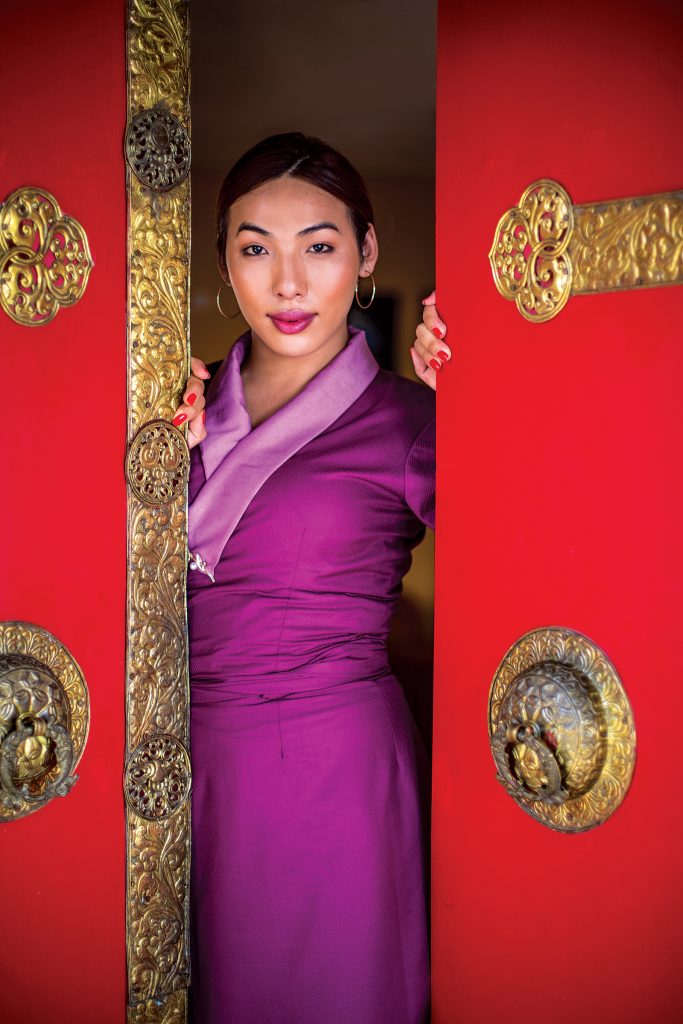When Tenzin Mariko decided to step out on stage at the 2015 Miss Tibet pageant, she knew that she was making a life-changing decision. A former monk, Mariko had left her monastery the year before in order to live as a woman. While she had been open about her gender with close friends, the pageant was the first time many in the Tibetan community learned that she was transgender. In fact, it was the first time they had encountered an openly trans person in general.
“I was so nervous when I was sitting backstage. I was literally saying, What will people think? Are they going to throw stones or eggs? It was really hard,” said Mariko, who is now in her early 20s. “Most of the people knew me as a monk, but when they saw me on stage people were so happy. It was so beautiful.”
Mariko had good reason to be nervous. In 2014, a video that showed her dancing at a close friend’s wedding while wearing a wig, five-inch heels, and full makeup, went viral on Tibetan social media. Tibetan culture does not widely accept those who identify as LGBTQ, and while His Holiness the Dalai Lama, the leader of the Gelug school and the world’s best-known Buddhist, has condemned violence against LGBTQ people, he has also expressed beliefs rooted in traditional Buddhist teachings that same-sex relationships are “sexual misconduct.” (In a 1997 meeting with representatives of the LGBTQ community, the Dalai Lama reportedly acknowledged a “willingness to consider the possibility that some [Buddhist] teachings may be specific to a particular cultural and historic context.”)
Related: What Does Gender Have to Do With the Dharma?
Gay monks were common in traditional Tibet, though this “accepted form of interaction between males . . . had no relationship to sexual or personal identity,” Buddhist scholar Jeff Wilson has written. Tibetan culture doesn’t recognize same-sex couples, and members of the LGBTQ community face “considerable legal and social obstacles,” according to James A. Wren in an article in The Himalayas: An Encyclopedia of Geography, History, and Culture.
Mariko at first denied that she was the woman in the video that was spreading across WeChat. It was only later that she came forward with the truth—and subsequently endured hurtful comments from strangers. (Mariko had been one of six brothers, and her family had discouraged her from expressing herself as a woman.) Her appearance at the pageant and the dance performances that followed were on Mariko’s own terms and signaled a turning point for the Tibetan LGBTQ community, with Mariko quickly becoming known as the first openly transgender Tibetan Buddhist. Since then she has appeared on several Indian reality television shows and performed as a dancer and model, and she is currently training to become a makeup artist. She has also given a TEDx talk in Dharamsala about her experience and has represented organizations such as the Tibetan National Women’s Soccer Team as a brand ambassador.
Even though Mariko had never heard the word transgender growing up in Himachal Pradesh, she always knew she was different from the other young monks she studied with at Samdrup Darjay Choling Monastery in Darjeeling. Together with one of her brothers, Mariko entered the monastery when she was 9; she later lived for three years at the Tergar Institute in Kathmandu, in the lineage of Yongey Mingyur Rinpoche.
Today, Mariko says she holds no ill will toward the people who laughed at or misunderstood her appearance, noting that many Tibetans were unfamiliar with transgender people until she herself decided to become so visible. Mariko’s newfound prominence as an LGBTQ celebrity also came at a time when India—the country she has lived in her whole life—was undergoing a great deal of change when it came to LGBTQ rights. After a years-long fight by activists, in 2018 the Indian Supreme Court overturned the colonial-era Section 377 of the Indian Penal Code, which criminalized gay sex.
Related: We’re Queer And We’ve Been Here
Although she now lives a secular life, Mariko still considers herself deeply religious and says she will always carry the Buddhist principles with her. “The person I am today is really because of the clear heart I discovered while at the monastery. Our religion stresses kindness,” Mariko said.
For this reason, she says, she continues to be drawn to charity work and to attend public events on LGBTQ issues in the Tibetan community. It is also because of studies in Buddhism, she says, that she never feels anger toward those who do not understand her gender identity or transition. “I never blame the public for not understanding me right away,” she explained, adding that it’s important for her to ensure that the public sees a visibly transgender Tibetan person.
Besides frequently talking to ordinary Tibetan Buddhists in the course of her work, Mariko also takes great pride in meeting with prominent teachers, including His Eminence Namkha Drimed Rinpoche and Tsoknyi Rinpoche. “I feel so blessed by the high rinpoches when I meet them,” she said. “They say, Mariko, you should be proud of yourself. You are showing something new to the society. They are saying, Just be yourself.”
Thank you for subscribing to Tricycle! As a nonprofit, we depend on readers like you to keep Buddhist teachings and practices widely available.
